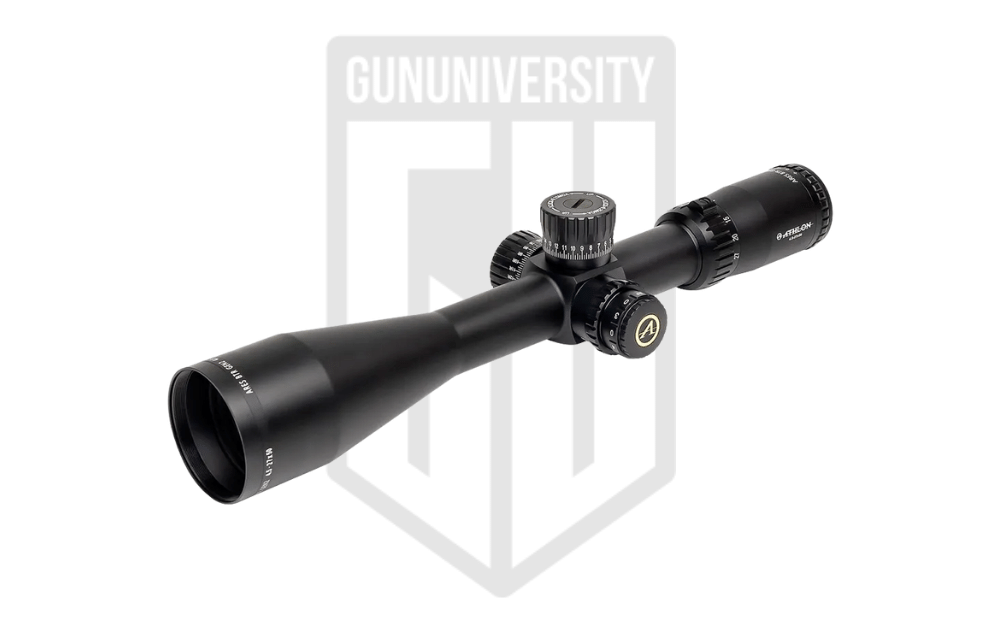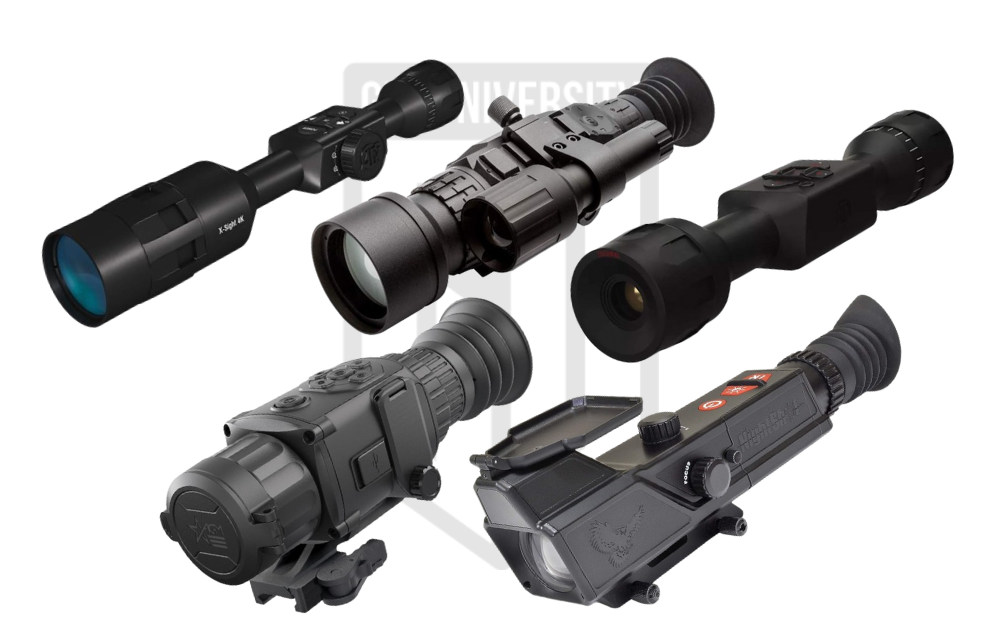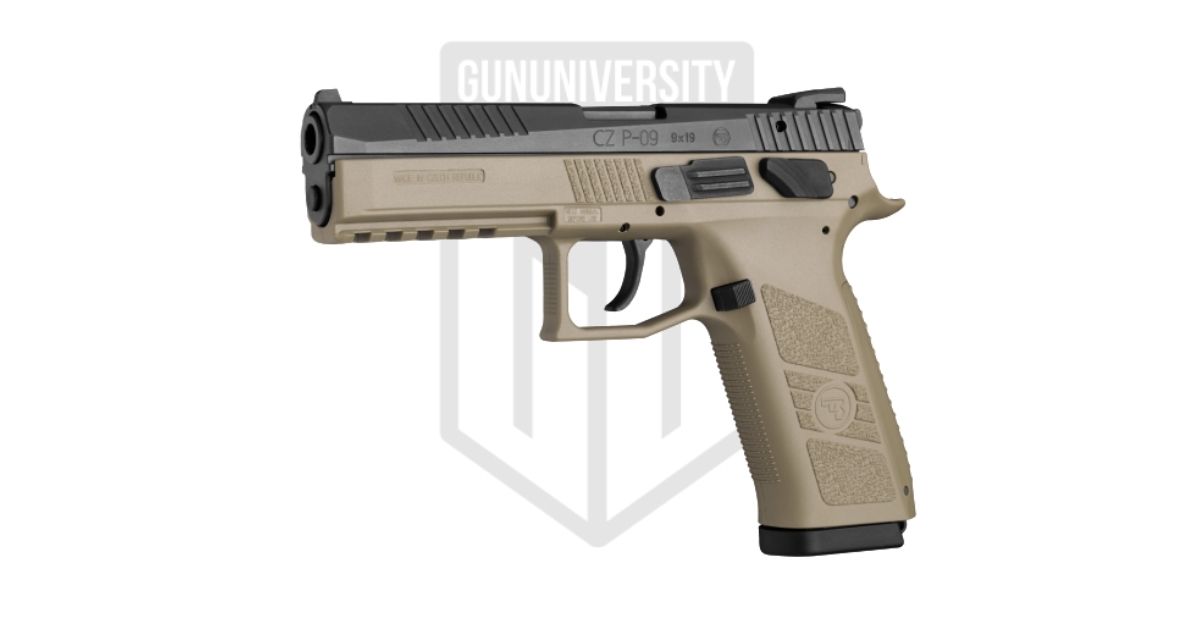Gun 101 – Getting Started with Firearms [videos]
So, you’re new to guns and you’re looking to learn the basics about firearms.
That’s awesome! We are so glad you’re here. Seriously.
All too often, people are shy or nervous about getting into firearms because they are worried about being unsafe or they are worried that the “gun community” won’t accept them (being concerned about safety is a great thing, worrying that you won’t be accepted isn’t).
You want to get into and learn about firearms? Come let us show you the basics of handling, shooting, and storing firearms.
In this Gun 101 article, we’re going to cover the basics of firearms for those new to guns:
- Firearm Safety
- Choosing the Right Firearm
- How to Purchase Firearms
- Firearm Handling
- Shooting Guns
- Firearm Training
- Storing Firearms
- Shooting Accessories
- Self Defense with a Firearm
- Concealed Carry (CCW) Resources
Basics of Firearm Safety
You might anxious to know how to pick the right firearm for you or how to get out and shoot your firearm, but we’re going to cover something MUCH more important first: Firearm Safety
Safe handling of firearms is PARAMOUNT! Do not be around, and especially don’t take advice from, ANYONE who demonstrates unsafe firearm handling. Firearms, by their nature, can be dangerous and deadly – they must be treated with respect and these rules should always be followed.
At RocketCCW, a resource for getting a CCW online, I offer the course content for free. I’ve decided to include some of the videos from the course here to help supplement this information about the basics of guns to help you get started.
Here’s a video on the basic firearm safety rules from the course (more details on each topic below):
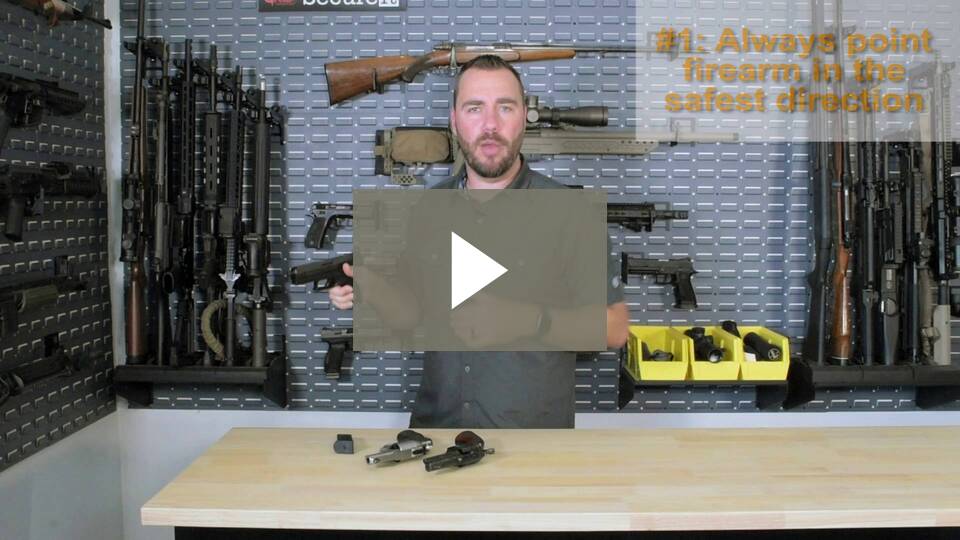
Just as there are many techniques and theories to shooting, there are also many versions of the rules of firearm safety. While I do not believe that any of the published rules by other entities are bad, I do believe that they are often too dense.
If firearm safety is not tangible to a new shooter, then it won’t be followed.
My personal rules of firearm safety are heavily based on the rules of firearm safety from a legend of firearm instruction, Col. Jeff Cooper.
There are 4 basic rules of firearm safety. The first three rules apply to handling firearms and the fourth rule applies to the use of firearms while shooting. I segregated the rules for handling firearms to help remind you that they apply every time you are around a firearm – not just while you are at the range.
Handling Firearms
#1 – Always Point the Firearm in the Safest Direction
You should NEVER point a firearm at anything that you are not willing to shoot (this includes “unloaded” guns… see rule #3 below).
I teach new shooters to treat the firearm like it always has a laser pointing down and out the barrel. If they are always conscious of where the imaginary laser is pointing and they never let the laser’s dot appear on anything they aren’t willing to shoot, then they’ll be following this rule.
Keep in mind that not pointing a firearm at anyone is great, but that doesn’t necessarily mean that any other direction is fine. For example, you may not want to shoot your TV, or worse, shoot through a wall and injure someone on the other side. Please remember that your home’s walls, especially interior walls, are nothing more than a couple pieces of drywall through which a bullet will easily pass.
There may be no 100% safe direction in your particular situation (even shooting concrete below your feet might cause injuries) but you need to be aware of the SAFEST direction at all times and be vigilant when watching others handle firearms.
#2 – Keep Your Finger Off the Trigger Until You Are Ready to Shoot
“Ready to shoot” means that the firearm is oriented towards the target and you are about to shoot – it does not mean that you have showed up to the range and you are ready to go to the firing line and shoot.This rule is easiest taught with a training device/non-firearm. We’ve included a link to our favorite one on Amazon here ->
Have the new shooter repeatedly pick up and handle the non-firearm until they can demonstrate that they can keep their finger not only off the trigger, but also positively aligned with the firearm’s frame.
My favorite restatement of this rule is… “Keep your booger hook off the bang switch.”
#3 – Treat All Guns as if They Are Loaded
If there is a most important rule, this is it.
I teach this rule to new shooters like this: “Never do anything with a firearm while using the excuse, ’don’t worry, it’s not loaded.’” If you treat every firearm with respect and you treat every firearm like it was loaded, then you’ll never break the other rules.
Take note that keeping a firearm’s safety “on” until you’re ready to shoot is not part of these rules! This is because mistakes can happen when shooters rely only on a gun’s “safety” as a safety device.
This is because firearm safeties are mechanical devices that can fail. Also, reliance on a safety alone often encourages shooters to break one of the other rules. For example, “yes, I’m pointing my gun at you but don’t worry, the safety is on” is an unacceptable excuse for poor firearm handling.
Firearm Use
#4 – Be Sure of Your Target, What is Around It, in Front of It, and Behind It
Every bullet that leaves your firearm is your responsibility – regardless of where it travels.
Once you fire a bullet, you can never bring it back!
Always ensure that you have an appropriate backstop and always think about where your bullet may travel if you miss your target.
If you are ever in doubt, stop what you are doing and confirm that your target area is safe for shooting.
Choosing the Right Firearm
The right firearm for you depends on your particular need/intended use for the firearm.
I am often asked “what kind of gun should I get?”
As an easier way to answer this question, I’ve learned to respond with “I don’t know. What kind of vehicle should I get?”
Analogizing a gun purchase to a vehicle purchase helps most people understand that there is no perfect firearm choice for everyone much like there is no perfect vehicle choice for everyone. We all have different needs, budget, and preferences.
Firearm Type
There are three main types of firearms that we’re going to discuss here: Rifles, Shotguns, and Handguns.
Rifles are shoulder fired weapons with spiral grooves in the barrel which spin the bullet to help stabilize its flight (think about spiral football). Rifles are typically higher powered than handguns (not always) but they always have a butt-stock to place in your shoulder while firing and usually have a place to grip the rifle for support with your non-firing hand.
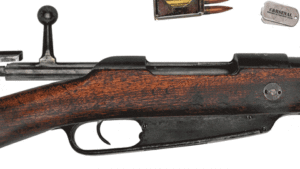
The most common type of rifles are bolt-action rifles where the rifle’s bolt must be manipulated between each shot (these are popular for hunting and long range target shooting) and semi-automatic rifles where the rifle cycles its own action between shots but there is still only one shot per trigger pull (these are popular for target shooting, competitions, defense, and hunting).
There are many more types of rifles, but you’re reading a “guns for dummies” article, remember?
To learn more about rifles, check out our RIFLE REVIEWS.
Handguns are firearms that are designed to be able to be fired with one hand (although we recommend using two hands if possible).
The two most popular types of handguns are revolvers which have a cylinder that rotates for each shot (think about a cowboy’s gun) and semi-auto pistols which hold ammunition in a magazine (typically in the grip of the pistol) and where a slide moves back and forth to cycle the action between shots (also only one shot per trigger pull).
The most popular revolvers are made by Smith and Wesson and Ruger whereas there are many manufacturers of semi-auto pistols that are popular.
Handguns are popular for target shooting, defense (both in and of the home), and competition.
If you need help deciding between any of them, you should be check out our HANDGUN REVIEWS.
Shotguns are smooth-barreled firearms with a butt-stock (meant to be fired from the shoulder) that fire shotgun shells. These shotgun shells can either be filled with tiny pellets/BBs (bird shot) for bird hunting or clay target shooting, big pellets (buck shot) for hunting or defense use, or slugs (one big chunk of lead) for hunting or defense use.
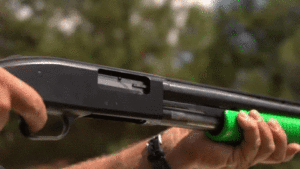
The three most popular types of shotguns are break-open shotguns (either single barrel or double barrel) where the action is opened by “breaking it open” to insert one or two shells and then closed to fire, pump-action shotguns where the frond must be pumped back and forth to load between shots, or semi-auto shotguns where the shotgun cycles the action between shots but it is still only one shot per trigger pull.
Shotguns are popular for hunting, competition, and home defense.
If you’d like to learn more about shotguns, check out our SHOTGUN REVIEWS.
Ammunition, although not a firearm, is still important to discuss here. You MUST ensure that you are using quality ammunition that is meant for your particular firearm.
The BEST way to confirm that you have the right ammunition is to ensure that the markings on the ammunition (or the box of ammunition) match the markings on the firearm. There are a few instances where there may not be an exact match (e.g. 9mm Luger is really the same as 9mm Parabellum and 45 ACP is the same as 45 AUTO) but in most cases the markings will be the same.
It’s also important to get the right ammunition for your intended use. Shooting slugs out of a shotgun will not only likely get you banned from the local trap and skeet range, you’ll also miss every target. Also, premium hollow-point ammunition is expensive as practice/range ammo and FMJ/ball practice ammo is not ideal for self defense.
If you’re in doubt, ASK someone when you are purchasing your ammo. We have plenty of information for you to learn more about ammunition including ammunition reviews, and articles on topics like gauge vs caliber and rimfire vs centerfire.
Firearm Purpose
The first thing we’re going to consider for helping you find out what type of firearm might be right for you is to look at what purpose you’ll be using the firearm.
For example, if you need to haul lumber as a construction worker, recommending a Toyota Prius as a vehicle would be bad advice. Likewise, if you wanted the best fuel efficiency for commuting, a pickup truck would similarly be bad for you. Note how each of those vehicles would be perfect for the other person.
Therefore, ask yourself (and be honest) what the main intended purpose of rate firearm will be. If you’re getting a gun for home-defense but you plan to take it to the range a few times a year to practice (you should), then the main purpose of the gun is home-defense even though you’re actually going to be actively “using” it more at the range.
This is an important distinction. A tiny and low-powered revolver might be fun to shoot but its extremely lacking as a home-defense weapon.

Firearms for Home Defense
If you’re looking for a firearm for home defense, there is no right answer for everyone on the type of firearm.
Handguns, rifles, and shotguns are all popular for home defense and many firearm experts disagree on what is best. This will be up to your particular needs.
Here, we’ll only discuss the pros and cons of each so that you can make a better decision.
| Firearm Type | Pros | Cons |
|---|---|---|
| Handgun (Revolver) | Reliable, Simple, Easy to store/hold | Low capacity, Difficult for some to use |
| Handgun (Pistol) | Higher capacity, Easier to shoot, Light mounting options | Less reliable (not a major issue with modern/quality firearms) |
| Shotgun (pump action) | Powerful, Relatively simple | Large, Heavy, Requires more training/practice to operate |
| Shotgun (semi-auto) | Powerful, Easy to operate | Large, Heavy, More likely to malfunction |
| Rifle (manual operation) | Powerful, Reliable | Large, Heavy, Slow to operate |
| Rifle (semi-auto) | Powerful, Easy to use, Light mounting options | Large, Heavy, More chance of malfunction |
Here are a few takeaways: I personally like a handgun because that’s what I carry anyway and store in a bedside lockbox every night for bed. However, in a bad spot, I’d almost always prefer a semi-auto rifle like an AR_15 style rifle.
Also, shotguns are NOT the mythical bad-guy dissuader that movies and some gun store salesmen make them out to be. The pellet will NOT spread so much that you don’t have to aim. The furthest distance in most houses down a hallway is likely not more than 25 yards and pellet will likely only spread out to around 10 inches at that distance. And no, you should not rely on the sound of a racking shotgun to make bad guys flee.
For a great discussion on which is best for home defense, a pistol, shotgun, or rifle, check out this great video by a Ranger-buddy of mine and all around good guy, John Lovell of Warrior Poet Society.
The only real suitable firearm type for concealed carry is a handgun.
When shopping for a handgun for concealed carry (also sometimes called CCW), get one small enough to conceal but large enough to use! One of the most common errors we see for new gun owners (especially women… sorry ladies), is getting a small gun because they think or they were told it would be easier for their smaller hands. This is almost always NOT true.
Tiny CCW guns can be the HARDEST to operate and shoot. Most women I’ve helped with firearms prefer compact but still reasonably full sized guns. Ladies, please stay away from micro guns and consider something that’s much easier to use and shoot, a Smith and Wesson M&P Shield EZ 9mm.
We have a TON OF CCW RESOURCES for you to help you know the laws, which guns we recommend, training, holsters and more.
Firearms for Competition/Sport
The good news: shooting guns for completion or sport is a TON of fun.
The bad news: there are some many different sports and recommendations for each that we couldn’t possibly cover them all here.
So, how do you know what the right type of firearm is for your range time or competition?
Go to one of the competitors and look at what people are using and look around. There’s a GREAT chance that someone will even let you borrow something to try out (I told you we’re a welcoming group). Just don’t forget your eye and ear protection!
Firearm Budget
What you can afford is up to you and your finances.
The maxim of ‘you get what you pay for” is mostly true with firearms but it has its limits. For example, if you’re just starting out and you want a handgun for CCW and home defense, then once you get passed about $600, you’re not going to see as much improvement for the money. Yes, a $2,000 custom 1911 is pretty, but it won’t be any better (in fact, I think it’d be worse) than a under-$600 Glock.
Please make sure you save some money from your budget for ammunition, a safe storage method, training, and quality accessories (holster for a handgun, etc.)
How to Purchase Firearms
There are many laws and regulations concerning the purchase of firearms. Unfortunately, because there are so many, we will only focus on federal laws and rules here (for now). Your state may have extra rules or restrictions on firearms purchases.
Federal Law on Purchasing Firearms
Under federal law, all new firearms must be transferred through a Federal firearm Licensee (FFL), otherwise known as gun shop or a gun dealer.
This means that whether you buy the gun from the local gun dealer while you’re in their gun shop or whether you buy the gun online, you must be present in a local gun shop (FFL) to fill out the paperwork and meet the background check requirements before you can take possession of the gun. This last step (the paperwork, ID, background check, etc.) is referred to as a “transfer.”
If you purchase a used firearm, however, the process MIGHT be different depending on your circumstances. As a note, even if the firearm is still in the box and has never been touched by the original purchaser, I’m going to consider that a used firearm for our purposes because it has been transferred to an individual and it is out of the FFL dealer system.
If you are purchasing a used firearm from a private party (another person / non-ffl) in your state, then, under federal law, you can make the transaction without using an FFL for the transfer. There’s no paperwork nor background check requirements. The only requirement is that the seller has no reason to believe that the purchaser is a prohibited person (a class of people who can’t possess firearms nor ammunition). please note: this is federal law only. your state might have extra restrictions on private party sales
If you are purchasing a used firearm from a gun dealer (FFL), then the same paperwork and background check requirements apply.
If you’re interested more in finding good deals for guns online, please check out: How to Buy a Gun Online
Straw Purchases
Although I’ve avoided getting into the nuances of firearms law here (which is tough because I’m literally a firearms attorney), I do want to address one VERY IMPORTANT part of the law… straw purchases.
A straw purchase is when someone buys a gun for someone else who can’t purchase it themselves. For example, if someone is a prohibited person and asks you to go into the gun store to buy the gun for them, this is a straw purchase and a serious crime (10 years in jail).
If you want to buy a firearm for someone else as a gift, this is legal (if it’s a true gift, you’re not getting reimbursed) but we think it makes so much more sense to just get them a gift card at the gun store so that they can go in and purchase what they eat and fill out the paperwork. To learn more about this, see: Firearms as Gifts
The National Shooting Sports Foundation has a great program to educate people about straw purchases and you’ll likely see these signs in your local gun shop. To learn more about their program, check out Don’t Lie for The Other Guy.
Firearm Handling
The topic of “handling firearms” is a big one because it covers what you should do ANYTIME you are dealing with guns: cleaning/maintaining them, storing them, taking them somewhere, shooting them, etc.
Here are some videos from the RocketCCW course that help cover the parts of handgun and how to load and unload a handgun (pistols and revolvers). Soon, we’ll have some more information here for rifles and shotguns.
Handgun Components

Unloading a Handgun
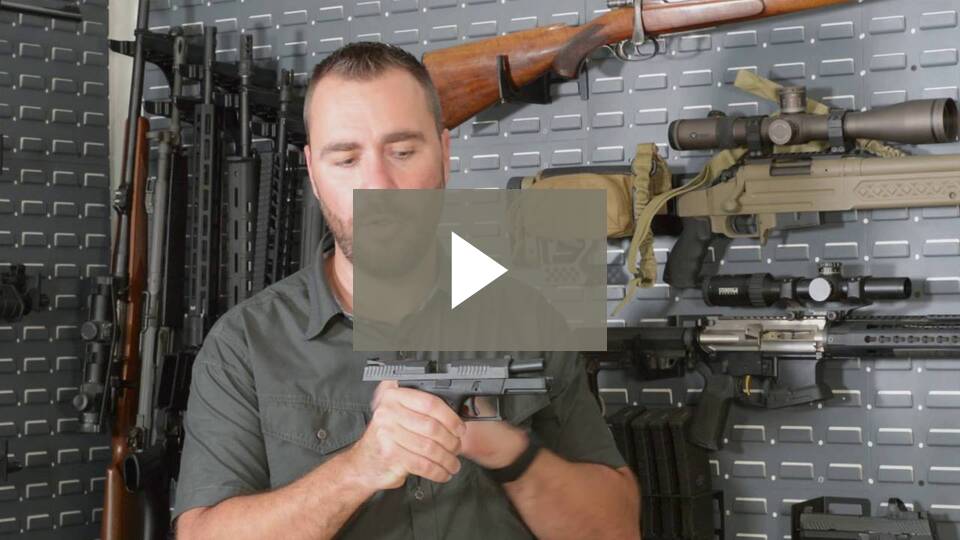
Loading a Handgun
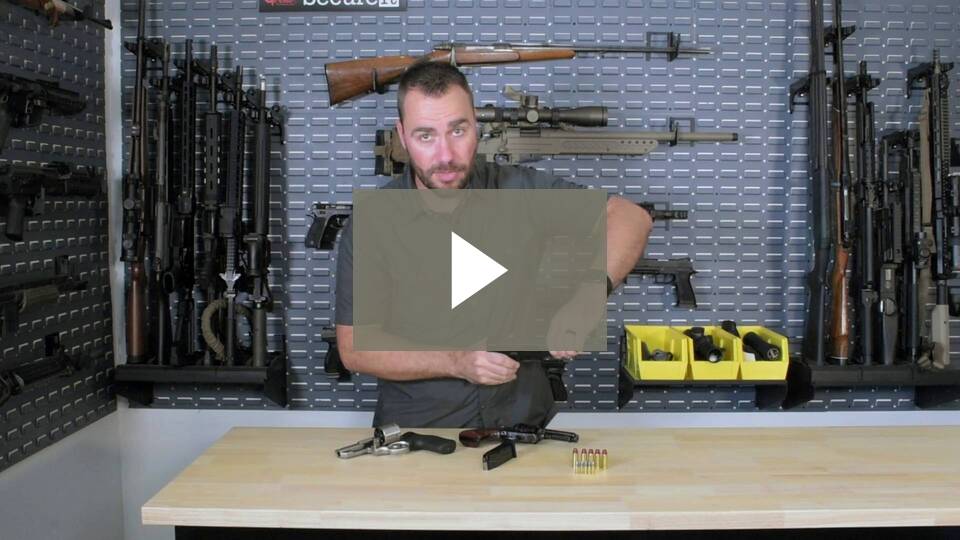
Shooting Guns
The topic of shooting guns can’t possibly be covered in one section of this article. Instead, we’ll start with some basic considerations and then add more later (check back!).
For now, if you’re looking for some more info on what to expect on your first trip to the range, you really should check out LetsGoShooting.org. They have a really cool tool that lets you search for and find gun ranges near you.
When you go to the range to shoot a gun, there’s a few things you should bring with you:
- Your firearm(s)
- Ammunition
- Magazines (if any)
- Eye Protection
- Ear Protection
- Case or bag to hold everything
You also should wear appropriate attire to the range.
If it’s an outdoor range you might be getting dirty/muddy. And when you’re shooting semi-auto firearms, the empty brass case is going to eject out of the firearm and it is going to be HOT! Even if you’re not shooting a semi-auto, someone else at the range might be.
Please consider what you are wearing and whether it could be a problem with a few pieces of hot brass flying in the air. Ladies, this means no low-cut tops. Everyone, this probably means no open toed shoes (although I’m guilty of being see running around the range in sandals… but, I’m weird).
The discussion points that we’ll cover in this section soon are stance, sight picture/sight alignment, recoil management, setting up targets, etc.
Here are some of the basics of pistol shooting from a great friend, Dave Miles, from a great organization, the NSSF:
Firearm Training
Proper firearm training is a MUST.
This is true even if you think you know what you’re doing with a firearm. A quality instructor will be able to make you better (and maybe even safer).
When I returned home from the military, I was offered a free spot in a fairly entry-level class at an established and well respected firearm training academy (Pistol 250 at Gunsite). I’ll be honest… if I had to enroll and pay as a normal student, I probably wouldn’t have gone purely because of ego. The course was above a intro to firearms course but still the most basic pistol course they offered
I had just finished a couple of tours to Afghanistan as a special operations sniper. Come on, I thought I knew what I needed to know about shooting.
I was wrong.
I learned so much in that course that forms my current technique and theory on shooting handguns! I became noticeably more proficient with a handgun. And, yes, there were some techniques I didn’t like/agree with. Guess what? Now I know why I don’t like a particular technique because I actually had it explained, tried it, and made up my own mind.
Right now, I would take the course again. It would be a great refresher and would help me focus on the basics.
If you’re new to firearms, you have no excuse for not taking a course that I would happily take.
As for where to go? There are TONS of great courses out there. My advice? Go to one of the bigger ranges/stores in your area and ask around. A good course and instructor will be professionally presented and will be to the middle/higher end of cost.
Also, look for a good teacher that is well groomed, can articulate what needs to be done, and makes you feel good about yourself and safe. At this point, please avoid the “tactical Dan” that wants to scream at you with chewing tobacco dripping from their lip and brags about how good they are. At this level you need a great teacher who might be a decent shooter – not the other way around.
Coronavirus Update:
So, I’ve encouraged you to go get firearm training and you’re stuck in your home because of the Coronavirus. Bummer.
There’s some good news, though! You can still train with your firearm at home!
Online Training
Online training can be a great way to learn how to shoot better while at home. However, please be VERY careful here. There are plenty of self-proclaimed firearms experts online… ALWAYS look to their resume to ensure that they are a subject matter expert and not just someone who watched some video themselves and put together their own version.
At GunUniversity we offer online firearm training courses from verified subject matter experts that we ourselves want to learn from. The list of courses and instructors is growing – keep an eye on the Gun University Courses
Another great resource for online training, especially for having a great grasp on the fundamentals, is Chris Sajnog. Chris is a former Navy SEAL and long time firearms instructor who has a really cool program that incorporates lots of online training and a membership community combined. As part of the community, he incorporates live Q&A sessions that I was recently a guest on… it was a ton of fun! I highly recommend Chris Sajnog’s Online Training Program/Community.
However, if you’re looking for one course to cover everything, you should start with his New Rules of Marksmanship Course.
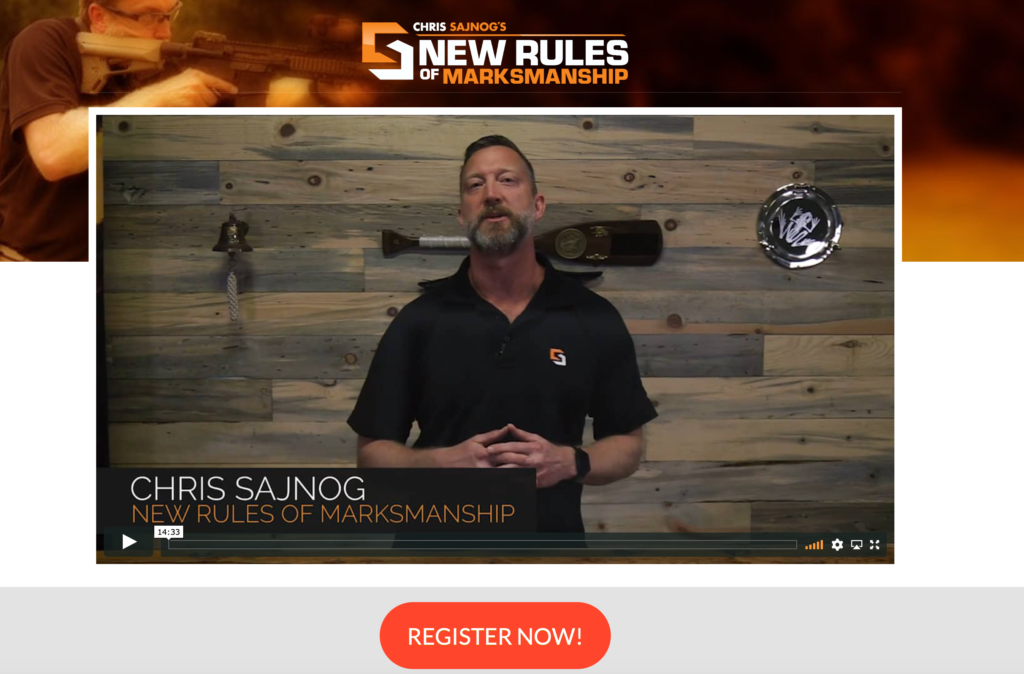
Here is the easiest way I can summarize my recommendation for the course: I considered making my own course on similar topics (effectively everything you need to get started shooting guns well) and realized that his is already so good, that it’s not worth trying to do my own. If you use one of our links to check out his course, it doesn’t cost you any extra but it does give us a little boost to our coffee budget.
The New Rules of Marksmanship course includes:
- 57 Video Lessons
- 46 quick-reference summaries
- A quick start guide
- Access to his “Team Room”
- and a ton more… it might be easier to go see all that the course offers
At-Home Firearm Training Tools
You can also train by yourself at home with some awesome firearm training tools.
You can either use your firearm or you can get a training tool/firearm.
If you want to use your firearm (a great choice especially if you’re new to guns), then the best training tool is the MantisX Dry Fire trainer. Yes, it’s perfectly safe to dry fire modern firearms. In fact, while you’re starting, I strongly believe that you should be dry-firing MORE than live-firing to build up your fundamentals.
The MantisX system is a device that mounts onto your firearm and then provides real-time feedback on how well you control your trigger.
The BIGGEST problem new shooters have is improper trigger control. The MantisX is the best system to fix that while at home. I use it nearly every day while I’m at my desk. Want to see how I’m doing with my training? Once you have your own MantisX system (I use and recommend the X10), you can search for people in the community to compare results and even compete if you want. You can look me up as “cleckner.” Feel free to give me a kick of motivation if I’m lacking in my practice.
You can get one directly from MantisX or you can find it on Amazon.
MantisX X10 on Amazon.comLASR App Software
Another cool tool for at home training is some software from the folks at LASR App.
You can make a “range” in your room with your webcam or smart device and then if you use a laser trainer, it can record your hits (and you can even race against the clock). It’s a ton of fun but it requires some setup and a laser trainer (see below)
They’re friends of ours and give you 10% off your order if you use the code “cleckner” at checkout.
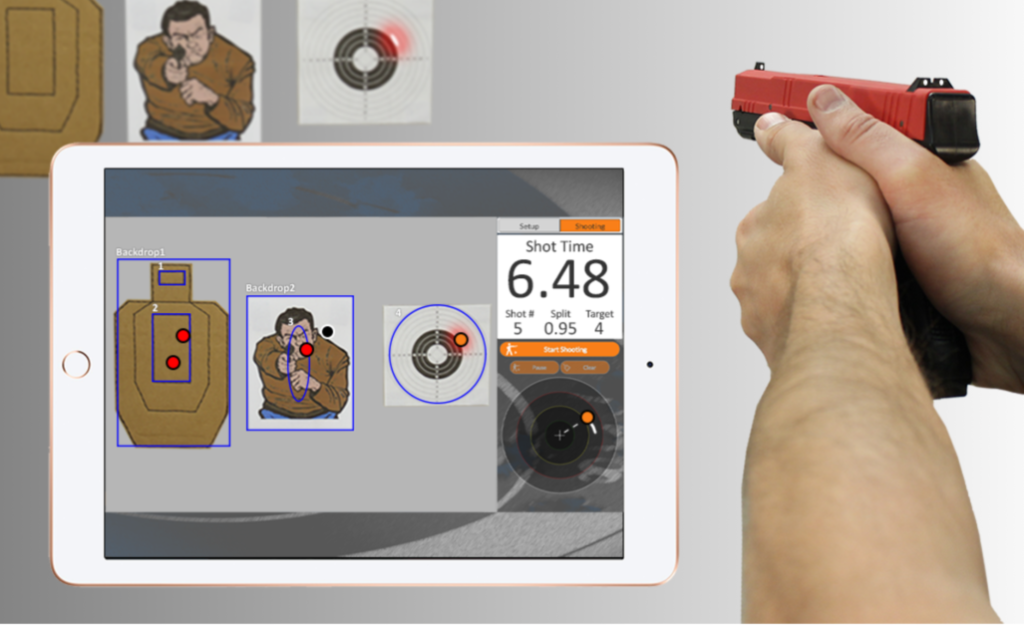
LasrAPP – Laser Firearm TrainerLaser Firearm Trainers
These can be great for practice, but if you’re new to firearms and need practice with YOUR actual firearm, please consider enrolling in the New Rules of Marksmanship course and getting the MantisX instead of one of these trainers so that you get comfortable with your actual firearm.
If you’d like to use the LasrAPP software above, or you’d like to have some fun with an actual trainer instead of a real firearm, then one of these laser trainers might be for you:
SIRT Pistol
The best laser trainer, especially if you shoot a Glock, is the SIRT Laser Pistol. You can get it at Brownells.com or from the LasrAPP store (above) for 10% off with the code “cleckner”
SIRT Laser PistolLaserLyte Trainer
Another option for laser training at home is the LaserLyte trainer (available on Amazon). However, this is more of a toy and not really a trainer to get you better at shooting YOUR firearm.
Storing Firearms
If you have a firearm it is your responsibility to store it properly.
Children, or unauthorized adults, should NEVER have unsupervised access to firearms.
Please please please get a safe storage solution.
Most guns come with cable gun locks that can be used to secure firearms. Although these can work, they aren’t very desirable. A much better solution for handguns that keeps kids hands off but allows you fast access for home defense, is a pistol lock box. My personal two favorites are the StopBox and the VaultTek LifePod (both on Amazon). Neither are actual “safes” and could be broken into with the right tools/motivation but they are great lock boxes to limit access to the firearms (especially by children).
We review some pistol safes here: Best Biometric Gun Safes
The NSSF runs another awesome program, Project Childsafe wherein free gun safety locks are distributed to communities. If you’d like some great resources for the safe storage of firearms, please go see Project Childsafe.
Shooting Accessories
Check out our gun reviews for the recommended accessories for each type of firearm: Gun Reviews
No matter what type of firearm you have, you’ll always need eye and ear protection and safe storage.
Self Defense With a Firearm
COMING SOON.
In the interim, if you’re looking for CCW insurance, we highly recommend CCW Safe in our Review and Comparison of Concealed Carry Insurance Options
Concealed Carry (CCW) Resources
Our best collection of CCW resources is in our Concealed Carry (CCW) Guide
If you’re one of the lucky among us that live in Tennessee, we’ve put together an article that shows you how to get an online CCW in Tennessee. Or, if you’re stuck in some other part of the country, you might want to check out the Virginia non-resident (or resident) CCW that you can get online and that works in over half the country…. but, they’ve officially closed the legal loophole that allows this and the new law will go into effect at the end of 2020. So, if you want to take advantage of the Virginia Online CCW, do it quick.
Recent Posts
April 25, 2024
April 24, 2024
April 22, 2024
April 19, 2024

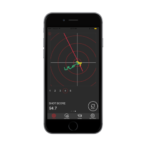
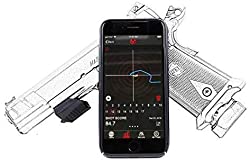
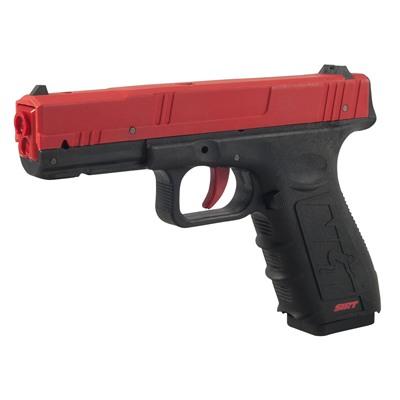
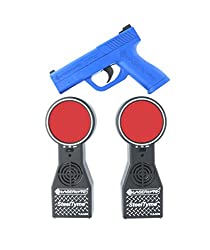
![Best Bullpup Rifles & Shotguns [2024]: Our Favorites!](https://gununiversity.com/wp-content/uploads/2021/09/Best-Bullpup-Rifles-and-Shotguns.jpg)
